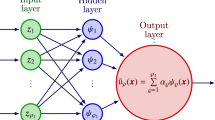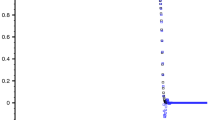Abstract
In this paper, the dynamical modeling and behavior analysis of the inverse boundary Stefan problem which promising the understanding of modeling brain tumor treatment, are studied. To umerical simulate these models and to overcome their difficulties such as, non-linearity, free boundary property and having a non-rectangular domain, we propose the use of a strongly meshless technique based on radial basis functions in conjunction with a (quasi)linearization algorithm. Numerical examples are given to show the good accuracy and stability of the presented method.











Similar content being viewed by others
References
Beck JV, Blackwell B, Clair C (1985) Inverse conduction Ill-posed problems. Wiley, Amsterdam
Canon JR (1984) The one dimensional heat equation. Cambridge University Press, Cambridge
Johansson BT, Lesnic D, Reeve T (2011) A method of fundamental solutions for the one-dimensional inverse Stefan problem. Appl Math Model 35:4367–4378
Johansson BT, Lesnic D, Reeve T (2011) Numerical approximation of the one-dimensional inverse Cauchy–Stefan problem using a method of fundamental solutions. Invese Probl Sci Eng 19:659–677
Johansson BT, Lesnic D, Reeve T (2011) A method of fundamental solutions for two-dimensional heat conduction. Int J Comput Math 88:1697–1713
Johansson BT, Lesnic D, Reeve T (2012) A method of fundamental solutions for radially symmetric and axisymmetric backward heat conduction problems. Int J Comput Math 89:1555–1568
Johansson BT, Lesnic D, Reeve T (2012) A method of fundamental solutions for the radially symmetric inverse heat conduction problem. Int Commun Heat Mass 39:887–895
Jaroudi R, Baravdish G, Johansson BT, Astrom F (2019) Numerical reconstruction of brain tumours. Inverse Prob Sci Eng 27:278–298
Chapkoa R, Johansson BT (2018) A boundary integral equation method for numerical solution of parabolic and hyperbolic cauchy problems. Appl Numer Math 129:104–119
Huntul M, Lesnic D, Johansson BT (2018) Determination of an additive time- and space-dependent coefficient in the heat equation. Int J Numer Meth Heat Fluid Flow 28:1352–1373
Hadian AH, Rad JA (2019) A computational source modeling of brain activity: an inverse problem. J Neurodev Cognit 1:50–56
Chakraverty S (2020) Mathematical methods in interdisciplinary sciences. Wiley, Amsterdam
Rashedi K, Adibi H, Rad JA, Parand K (2014) Application of the meshfree methods for solving the inverse one-dimensional Stefan problem. Eng Anal Bound Elem 40:1–21
Sarabadan S, Rashedi K, Adibi H (2018) Boundary determination of the inverse heat conduction problem in one and two dimensions via the collocation method based on the satisfier functions. Iran J Sci Technol Trans Sci 42:827–840
Gol’dman NL (1997) Inverse Stefan problems. Kluwer Academic Publ, Beijing
Lamé G, Clapeyron BP (1831) Mémoire sur la solidification par refroidissement d’un globe solide. Ann Chem Phys 47:250–256
Rubinsteın LI (1971) The Stefan problem. American Mathematical Society, New York
Stefan J (1889) Uber einige Probleme der Theorie der Wärmeleitung. S-B Wien Akad Mat Natur 98:473–484
Johansson BT, Lesnic D, Reeve T (2014) A method of fundamental solutions for the two-dimensional inverse Stefan problem. Inverse Probl Sci Eng 22:112–129
Hsieh MH (2012) Mathematical modelling of controlled drug release from polymer micro-spheres: incorporating the effects of swelling, diffusion and dissolution via moving boundary problems. Ph.D. thesis, Queensland University of Technology
Hsieh M, McCue SW, Moroney TJ, Nelson MI (2011) Drug diffusion from polymeric delivery devices: a problem with two moving boundaries. ANZIAM J 52:549–566
Kipper MJ, Narasimhan B (2005) Molecular description of erosion phenomena in biodegradable polymers. Macromolecules 38:1989–1999
Faisant N, Akiki J, Siepmann F, Benoit JP, Siepmann J (2006) Effects of the type of release medium on drug release from PLGA-based microparticles: experiment and theory. I. J Pharmaceutics 314:189–197
Lao LL, Venkatraman SS, Peppas NA (2008) Modeling of drug release from biodegradable polymer blends. Eur J Pharm Biopharm 70:796–803
McCue SW, Hsieh M, Moroney TJ, Nelson MI (2011) Asymptotic and numerical results for a model of solvent-dependent drug diffusion through polymeric spheres. SIAM J Appl Math 71:2287–2311
Wei T, Yamamoto M (2009) Reconstruction of a moving boundary from Cauchy data in one-dimensional heat equation. Inverse Probl Sci Eng 17:551–567
Liu J, Guerrier B (1997) A comparative study of domain embedding method for regularized solutions of inverse Stefan problems. Int J Numer Methods Eng 40:3579–3600
Hon YC, Li M (2008) A computational method for inverse free boundary determination problem. Int J Numer Methods Eng 73:1291–1309
Fredman TP (2004) A boundary identification method for an inverse heat conduction problem with an application in ironmaking. Heat Mass Transf 41:95–103
Badia AE, Moutazaim F (1999) A one-phase inverse Stefan problem. Inverse Prob 15:1507–1522
Larsson E, Shcherbakov V, Heryudono A (2017) A least squares radial basis function partition of unity method for solving PDEs. SIAM J Sci Comput 39:A2538–A2563
Shcherbakov V, Larsson E (2016) Radial basis function partition of unity methods for pricing vanilla basket options. Comput Math Appl 71:185–200
Safdari-Vaighani A, Heryudono A, Larsson E (2015) A radial basis function partition of unity collocation method for convection-diffusion equations arising in financial applications. J Sci Comput 64:341–367
Shcherbakov V (2016) Radial basis function partition of unity operator splitting method for pricing multi-asset American options. BIT Numer Math 56:1401–1423
Dehghan M, Ghesmati A (2010) The Meshless Local Petrov-Galerkin (MLPG) method: a simple and less-costly alternative to the finite element and boundary element methods. Eng Anal Bound Elem 34:324–336
Dehghan M, Mirzaei D (2009) Meshless local boundary integral equation (LBIE) method for the unsteady magnetohydrodynamic (MHD) flow in rectangular and circular pipes. Comput Phys Commun 180:1458–1466
Rad JA, Parand K, Ballestra LV Pricing European and American options by radial basis point interpolation. Appl Math Comput 251(201):363–377
Assari P, Adibi H, Dehghan M (2013) A meshless method for solving nonlinear two-dimensional integral equations of the second kind on non-rectangular domains using radial basis functions with error analysis. J Comput Appl Math 239:72–92
Assari P, Adibi H, Dehghan M (2014) A meshless discrete galerkin (MDG) method for the numerical solution of integral equations with logarithmic kernels. J Comput Appl Math 267:160–181
Dehghan M, Najafi M (2016) Numerical solution of a non-classical two-phase Stefan problem via radial basis function (RBF) collocation methods. Eng Anal Bound Element 72:111–127
Hemami M, Parand K, Rad JA (2019) Numerical simulation of reaction–diffusion neural dynamics models and their synchronization desynchronization: application to epileptic seizures. Comput Math Appl 78:3644–3677
Shirzadi A, Ling L, Abbasbandy S (2012) Meshless simulations of the two-dimensional fractional-time convection–diffusion-reaction equations. Eng Anal Bound Elem 36:1522–1527
Abbasbandy S, Shirzadi A (2011) MLPG method for two-dimensional diffusion equation with Neumann’s and non-classical boundary conditions. Appl Numer Math 61:170–180
Abbasbandy S, Ghehsareh HR, Alhuthali MS, Alsulami HH (2014) Comparison of meshless local weak and strong forms based on particular solutions for a non-classical 2-D diffusion model. Eng Anal Bound Elem 39:121–128
Dehghan M, Mirzaei D (2009) Meshless local Petrov-Galerkin (MLPG) method for the unsteady magnetohydrodynamic (MHD) flow through pipe with arbitrary wall conductivity. Appl Numer Math 59:1043–1058
Dehghan M, Mirzaei D (2008) The meshless local Petrov-Galerkin MLPG method for the generalized two-dimensional non-linear Schrodinger equation. Eng Anal Bound Elem 32:747–756
Mohammadi V, Dehghan M (2018) Simulation of the phase field Cahn–Hilliard and tumor growth models via a numerical scheme: element-free Galerkin method. Comput Methods Appl Mech Eng in press
Dehghan M, Narimani N (2018) An element-free Galerkin meshless method for simulating the behavior of cancer cell invasion of surrounding tissue. Appl Math Model 59:500–513
Dehghan M, Abbaszadeh M (2016) Numerical study of three-dimensional Turing patterns using a meshless method based on moving Kriging element free Galerkin (EFG) approach. Comput Math Appl 72:427–454
Dehghan M, Abbaszadeh M (2018) A combination of proper orthogonal decomposition-discrete empirical interpolation method (POD-DEIM) and meshless local RBF-DQ approach for prevention of groundwater contamination. Comput Math Appl 75:1390–1412
Cheung K, Ling L (2018) A Kernel-based embedding method and convergence analysis for surfaces PDEs. SIAM J Sci Comput 40:A266–A287
Petras A, Ling L, Ruuth S (2018) An RBF-FD closest point method for solving PDEs on surfaces. J Comput Phys 370:43–57
Kansa EJ (1990) Multiquadrics-A scattered data approximation scheme with applications to computational fluid-dynamics-I surface approximations and partial derivative estimates. Comput Math Appl 19:127–145
Kansa EJ (1990) Multiquadrics-A scattered data approximation scheme with applications to computational fluid-dynamics II. solutions to parabolic, hyperbolic and elliptic partial differential equations. Comput Math Appl 19:147–161
Sharan M, Kansa EJ, Gupta S (1997) Application of the multiquadric method for numerical solution of elliptic partial differential equations. Appl Math Comput 84:275–302
Milovanović S, Sydow L (2018) Radial basis function generated finite differences for option pricing problems. Comput Math Appl 75:1462–1481
Jafarabadi A, Shivanian E (2018) Numerical simulation of nonlinear coupled Burgers’ equation through meshless radial point interpolation method. Eng Anal Bound Elem 95:187–199
Shivanian E, Jafarabadi A (2018) The spectral meshless radial point interpolation method for solving an inverse source problem of the time-fractional diffusion equation. Appl Numer Math 129:1–25
Shivanian E, Jafarabadi A (2018) Capillary formation in tumor angiogenesis through meshless weak and strong local radial point interpolation. Eng Comput 34:603–619
Shivanian E, Jafarabadi A (2018) An improved meshless algorithm for a kind of fractional cable problem with error estimate. Chaos Solit Fract 110:138–151
Rad JA, Hook J, Larsson E, Sydow L (2018) Forward deterministic pricing of options using Gaussian radial basis functions. J Comput Sci 24:209–217
Rad JA, Parand K (2017) Numerical pricing of American options under two stochastic factor models with jumps using a meshless local Petrov–Galerkin method. Appl Numer Math 115:252–274
Rad JA, Parand K, Abbasbandy S (2015) Pricing European and American options using a very fast and accurate scheme-the meshless local Petrov–Galerkin (MLPG). Proc Natl Acad Sci India Sect A Phys Sci 85:337–351
Rad JA, Parand K, Abbasbandy S (2015) Local weak form meshless techniques based on the radial point interpolation (RPI) method and local boundary integral equation (LBIE) method to evaluate European and American options. Commun Nonlinear Sci Numer Simulat 22:1178–1200
Rippa S (1999) An algorithm for selecting a good parameter \(c\) in radial basis function interpolation. Adv Comput Math 11:193–210
Fornberg B, Wright G (2004) Stable computation of multiquadric interpolants for all values of the shape parameter. Comput Math Appl 48:853–867
Landau HG (1950) Heat conduction in a melting solid. Q Appl Math 8:81–94
Blackwell BF, Hogant RE (1994) One-dimensional ablation using Landau transformation and finite control volume procedure. J Thermophys Heat Transf 8:282–287
Parand K, Lotfi Y, Rad JA (2017) An accurate numerical analysis of the laminar two-dimensional flow of an incompressible Eyring–Powell fluid over a linear stretching sheet. Eur Phys J Plus 132:397
Parand K, Delkhosh M (2017) Accurate solution of the Thomas–Fermi equation using the fractional order of rational Chebyshev functions. J Comput Appl Math 317:624–642
Mandelzweig VB, Tabakin F (2001) Quasilinearization approach to nonlinear problems in physics with application to nonlinear ODEs. Comput Phys Commun 141:268–281
Ramos JI (2004) Piecewise quasilinearization techniques for singular boundary-value problems. Comput Phys Commun 158:12–25
El-Gebeily M, O’Regan D (2006) A generalized quasilinearization method for second-order nonlinear differential equations with nonlinear boundary conditions. J Comput Appl Math 192:270–281
Fasshauer G (2007) Meshfree approximation methods with MATLAB. Word Scientific Publishing, Singapore
Haq S, Islam S, Uddin M (2009) A mesh-free method for the numerical solution of the KdV-Burgers equation. Appl Math Model 33:3442–3449
Mokhtari R, Mohammadi M (2010) Numerical solution of GRLW equation using Sinc-collocation method. Comput Phys Commun 181:1266–1274
Author information
Authors and Affiliations
Corresponding author
Additional information
Publisher's Note
Springer Nature remains neutral with regard to jurisdictional claims in published maps and institutional affiliations.
Rights and permissions
About this article
Cite this article
Hajiollow, A., Lotfi, Y., Parand, K. et al. Recovering a moving boundary from Cauchy data in an inverse problem which arises in modeling brain tumor treatment: the (quasi)linearization idea combined with radial basis functions (RBFs) approximation. Engineering with Computers 37, 1735–1749 (2021). https://doi.org/10.1007/s00366-019-00909-8
Received:
Accepted:
Published:
Issue Date:
DOI: https://doi.org/10.1007/s00366-019-00909-8




